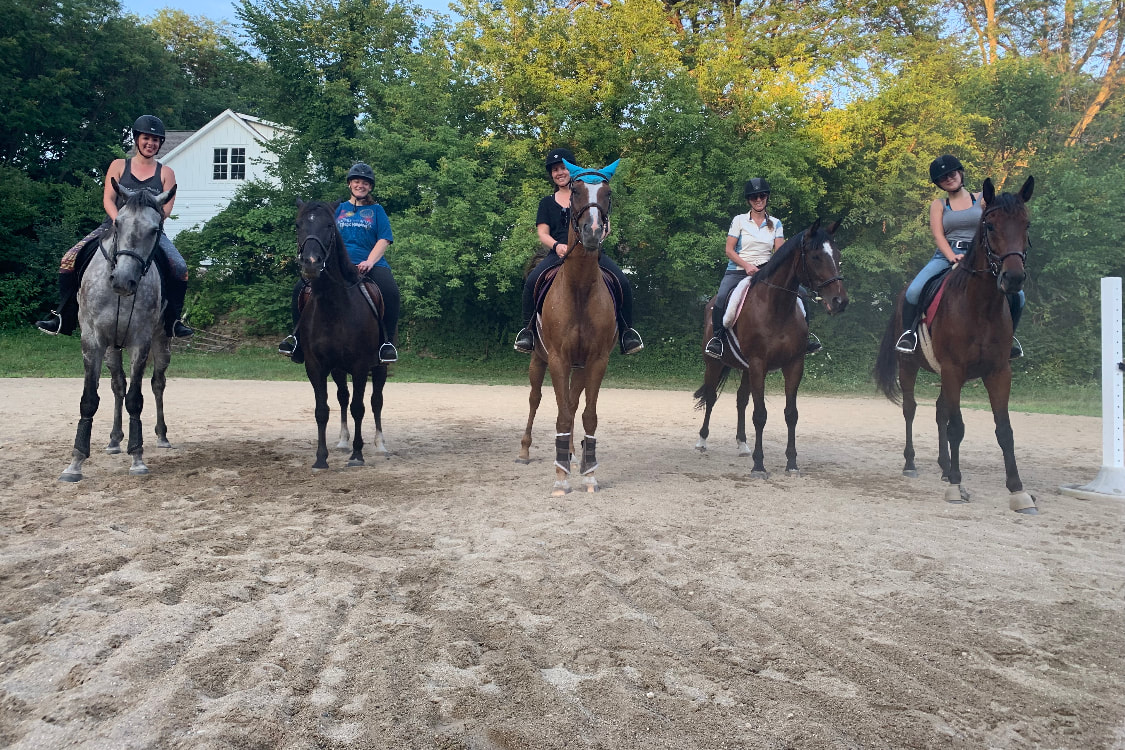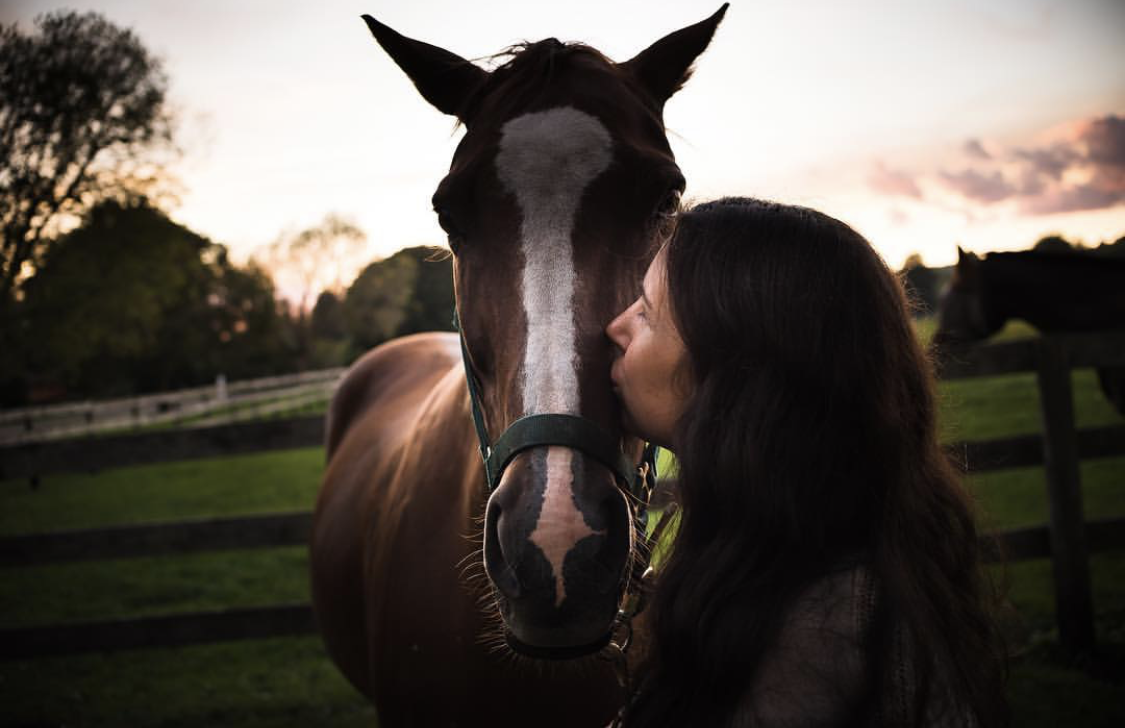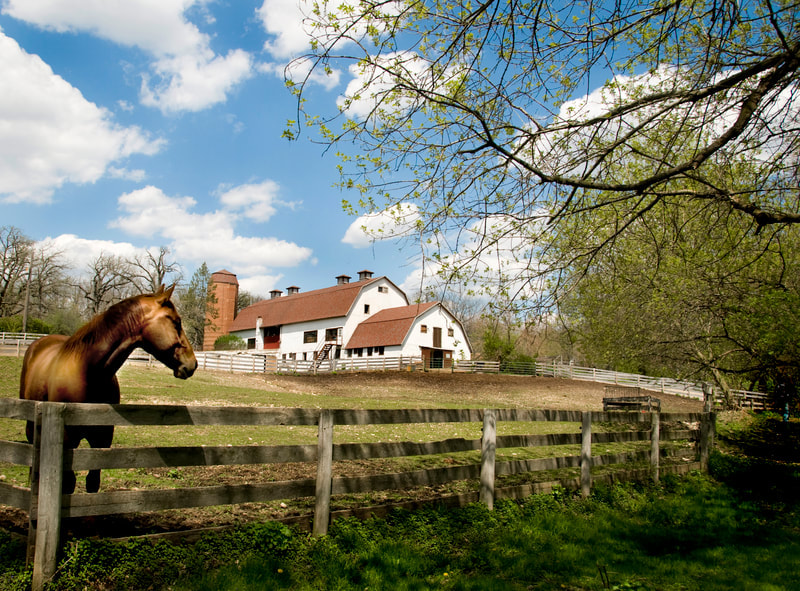Riding Club
Equestrian sport is deep rooted in the history of Trout Valley - from horse racing to polo - and the Trout Valley Riding Club is a club that brings horse lovers together. The TVRC is a co-op club that uses the lower level of the Trout Valley barn to board horses. To board a horse, you must be a club member and resident of Trout Valley. Members of the Riding Club have access to the Barn, outdoor arena, 3 adjacent paddocks, upper pasture, lower pasture, and trails.
About:
The Trout Valley Riding Club is a not-for-profit club of the Trout Valley Association. The purpose is to perpetuate the interest in horses and riding for the mutual benefit of Trout Valley Association members by regulating the use of horses and riding facilities. The Trout Valley Riding Club, and all its associated Trout Valley Association amenities, shall not be used as a means to conduct business, nor shall a horse stabled within Trout Valley be used as a means for profit.
The Trout Valley Riding Club is a not-for-profit club of the Trout Valley Association. The purpose is to perpetuate the interest in horses and riding for the mutual benefit of Trout Valley Association members by regulating the use of horses and riding facilities. The Trout Valley Riding Club, and all its associated Trout Valley Association amenities, shall not be used as a means to conduct business, nor shall a horse stabled within Trout Valley be used as a means for profit.
TVRC Board:
Katie Krysh - President
Mike Murphy - Vice President
Ed Kuhner - Treasurer
Alyssa Murphy - Secretary
Katie Krysh - President
Mike Murphy - Vice President
Ed Kuhner - Treasurer
Alyssa Murphy - Secretary
Meet Your Neighhhbors:
The majority of the horses currently housed at the Trout Valley Barn are off the track Thoroughbreds!
Autumn - Chestnut Thoroughbred Mare
Beau - Chestnut Quarter Horse/Thoroughbred Gelding
Bleu - Dark Bay Thoroughbred Gelding
Captain - Palamino Quarter Horse Gelding
Dusty - Buckskin Gelding
Gambler - Bay Thoroughbred Gelding
Jordan - Bay Thoroughbred Gelding
Lacey - Paint Mare
Layla - Paint Pony Mare
Lumos - Gray Thoroughbred Gelding
Scooter - Bay Quarter Horse Gelding
The majority of the horses currently housed at the Trout Valley Barn are off the track Thoroughbreds!
Autumn - Chestnut Thoroughbred Mare
Beau - Chestnut Quarter Horse/Thoroughbred Gelding
Bleu - Dark Bay Thoroughbred Gelding
Captain - Palamino Quarter Horse Gelding
Dusty - Buckskin Gelding
Gambler - Bay Thoroughbred Gelding
Jordan - Bay Thoroughbred Gelding
Lacey - Paint Mare
Layla - Paint Pony Mare
Lumos - Gray Thoroughbred Gelding
Scooter - Bay Quarter Horse Gelding
Although horses are beautiful and fun to see, they are often unpredictable and care must be taken when living together in the community. Here are a few rules to keep everyone safe:
- Don’t go into the stable area unless you’re accompanied by the TVRC member
- Horses bite – keep hands, especially your fingers, away from their muzzles
- Although most horses like apples and carrots, PLEASE do NOT feed the horses – extra food can cause a horse to become very sick
- Never open gates – sometimes you may not see a horse in a field, but if they are there and can leave the field, they are in great danger from cars
- Our Trout Valley roads are narrow, but are shared by horses, cars, bikes and motorcycles. PLEASE, drive slowly and give extra room when you pass horses to help ensure the horses and their riders are as safe as possible
- Don’t shout at horses when you pass by them – loud noises can startle a horse, possibly causing them to jump or bolt
History:
It is estimated that the Barn was built in 1890. The Trout Valley horse show, a must attend event for equestrians, continued in 1963 and many years after. The Trout Valley horse shows typically ran over a three day period and featured a tightly packed schedule of riding and show contest events. The weekend also entailed a dinner and dance social event held at the Barn.
Trout Valley is also deep rooted in American horse racing. One of only 13 Triple Crown winners, Count Fleet, was sired by Reigh Count. Foaled at Court Manor Stud in Virginia, Reigh Count was bred by Willis Sharpe Kilmer. Reigh Count was purchased by John D. Hertz for an amount variously reported as US$10,000 or US$12,500 during his juvenile season; afterward, the colt raced in the colors of Hertz's wife Fannie.
According to John D. “Trader” Clark, Hertz made the decision to buy Reigh Count after watching the colt try to savage a passing rival in a juvenile race at Saratoga. An ex-prizefighter, Hertz later said that what attracted him to the colt was the animal's evident desire to win even when he had no energy left, a quality he had seen in young boxers who later became champions.
Reigh Count was trained by Henry McDaniel prior to his sale and by Bert S. Michell afterward. He initially stood at stud at Leona Heights Stock Farm in TROUT VALLEY, Illinois, where he had limited opportunities. He moved to Claiborne Farm in 1936 and stood there through the 1939 breeding season.
It is estimated that the Barn was built in 1890. The Trout Valley horse show, a must attend event for equestrians, continued in 1963 and many years after. The Trout Valley horse shows typically ran over a three day period and featured a tightly packed schedule of riding and show contest events. The weekend also entailed a dinner and dance social event held at the Barn.
Trout Valley is also deep rooted in American horse racing. One of only 13 Triple Crown winners, Count Fleet, was sired by Reigh Count. Foaled at Court Manor Stud in Virginia, Reigh Count was bred by Willis Sharpe Kilmer. Reigh Count was purchased by John D. Hertz for an amount variously reported as US$10,000 or US$12,500 during his juvenile season; afterward, the colt raced in the colors of Hertz's wife Fannie.
According to John D. “Trader” Clark, Hertz made the decision to buy Reigh Count after watching the colt try to savage a passing rival in a juvenile race at Saratoga. An ex-prizefighter, Hertz later said that what attracted him to the colt was the animal's evident desire to win even when he had no energy left, a quality he had seen in young boxers who later became champions.
Reigh Count was trained by Henry McDaniel prior to his sale and by Bert S. Michell afterward. He initially stood at stud at Leona Heights Stock Farm in TROUT VALLEY, Illinois, where he had limited opportunities. He moved to Claiborne Farm in 1936 and stood there through the 1939 breeding season.
Meetings:
Regular meetings of the Riding Club will be held bi-monthly on a day of the week mutually chosen by the officers. At least 6 meetings will be held annually, not more than 3 months apart or closer than one month apart (except for special meetings called by the board).
Regular meetings of the Riding Club will be held bi-monthly on a day of the week mutually chosen by the officers. At least 6 meetings will be held annually, not more than 3 months apart or closer than one month apart (except for special meetings called by the board).
Membership:
Any Trout Valley resident may become a social member of the Riding Club by paying a $25.00 annual fee. Social members will receive any newsletters and are encouraged to participate in club activities, must sign a hold harmless and initial a copy of the bylaws, are permitted to shareboard or lease a horse that is currently owned by a Trout Valley Riding Club member, are permitted to enter the stabling area without an accompanying horse owner, and are encouraged to help with barn and horse related chores and fundraising events. Social members must be good standing members of the TVA, currently owning property in Trout Valley, and have an interest in participating in and promoting equine activities within Trout Valley. Social members may not vote nor will they pay the initiation fee or any assessments. A social member who wishes to bring a horse into Trout Valley must pay the full initiation fee in effect at that time.
The Riding Club is responsible for the sanitation of the stable area and the proper and humane care of animals. It is necessary for the Riding Club to control the use of the facilities. Therefore, any Trout Valley Association member who wishes to keep a horse or pony is required to become a member of the Trout Valley Riding Club and abide by the rules and regulations, and thereby share in the responsibility for regulating horses and riding facilities.
Trout Valley dues do not include the cost of maintaining a horse in Trout Valley. There is no charge for the use of the stable which is Trout Valley property. The monthly fee will be computed based on the average monthly expense per horse covering the purchase of hay, bedding, hired help, utilities and general maintenance items. All members shall pay any special assessments. Members holding stalls shall pay their proportionate share of all fixed monthly expenses.
An applicant shall first be a member in good standing of the Trout Valley Association and agree to the rules and regulations set up by the Riding Club. A membership in the Riding Club requires an initiation fee which will buy a share in the equipment owned by the members.
This one fee covers all horses owned by one member. It is not transferable nor refundable upon a membership being terminated, nor is it to be applied against dues owed. A member selling or removing his horse will automatically have his membership continued for one year on a non-voting basis. During this year he will not be required to pay any assessments voted after removal of his horse(s) from Trout Valley. After one year, anyone wishing to bring a horse into Trout Valley must pay the initiation fee again. Any member who moves his horse(s) after an assessment is voted but before paying the
assessment must pay the assessment in addition to the initiation fee, if applicable (one year elapsed) before he may bring a horse into Trout Valley or use the riding facilities.
Association members will be limited to the use of a maximum of three horses and one stall for each horse per family.
Any Trout Valley resident may become a social member of the Riding Club by paying a $25.00 annual fee. Social members will receive any newsletters and are encouraged to participate in club activities, must sign a hold harmless and initial a copy of the bylaws, are permitted to shareboard or lease a horse that is currently owned by a Trout Valley Riding Club member, are permitted to enter the stabling area without an accompanying horse owner, and are encouraged to help with barn and horse related chores and fundraising events. Social members must be good standing members of the TVA, currently owning property in Trout Valley, and have an interest in participating in and promoting equine activities within Trout Valley. Social members may not vote nor will they pay the initiation fee or any assessments. A social member who wishes to bring a horse into Trout Valley must pay the full initiation fee in effect at that time.
The Riding Club is responsible for the sanitation of the stable area and the proper and humane care of animals. It is necessary for the Riding Club to control the use of the facilities. Therefore, any Trout Valley Association member who wishes to keep a horse or pony is required to become a member of the Trout Valley Riding Club and abide by the rules and regulations, and thereby share in the responsibility for regulating horses and riding facilities.
Trout Valley dues do not include the cost of maintaining a horse in Trout Valley. There is no charge for the use of the stable which is Trout Valley property. The monthly fee will be computed based on the average monthly expense per horse covering the purchase of hay, bedding, hired help, utilities and general maintenance items. All members shall pay any special assessments. Members holding stalls shall pay their proportionate share of all fixed monthly expenses.
An applicant shall first be a member in good standing of the Trout Valley Association and agree to the rules and regulations set up by the Riding Club. A membership in the Riding Club requires an initiation fee which will buy a share in the equipment owned by the members.
This one fee covers all horses owned by one member. It is not transferable nor refundable upon a membership being terminated, nor is it to be applied against dues owed. A member selling or removing his horse will automatically have his membership continued for one year on a non-voting basis. During this year he will not be required to pay any assessments voted after removal of his horse(s) from Trout Valley. After one year, anyone wishing to bring a horse into Trout Valley must pay the initiation fee again. Any member who moves his horse(s) after an assessment is voted but before paying the
assessment must pay the assessment in addition to the initiation fee, if applicable (one year elapsed) before he may bring a horse into Trout Valley or use the riding facilities.
Association members will be limited to the use of a maximum of three horses and one stall for each horse per family.



